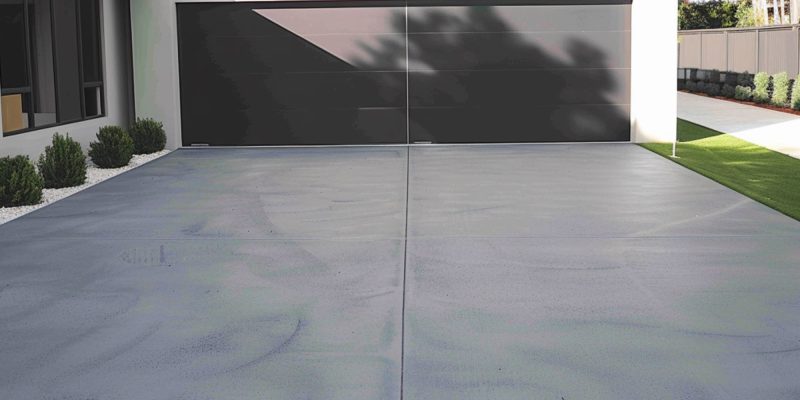When considering a new driveway, knowing the right size to choose can make a big difference. It affects not just how your property looks but also how well it functions daily. Whether you’re building from scratch or upgrading, selecting the appropriate driveway size is key to accommodating your vehicles comfortably and enhancing your home’s appeal.
Basics and Importance
When it comes to driveways, one size definitely does not fit all. The right driveway size for your home depends on several factors, but understanding the basics is a great starting point.
Overview of Driveway Types and Typical Dimensions
Driveways primarily come in three types: single, double, and triple. Each type is designed to fit a specific number of vehicles:
- Single Driveway: Ideal for one car, typical widths range from 10 to 12 feet.
- Double Driveway: Designed for two cars side by side, these are usually 20 to 24 feet wide.
- Triple Driveway: For three cars or more, widths start at 30 feet and increase depending on the number of vehicles.
Importance of Correct Sizing
Choosing the correct driveway size is crucial. A driveway that’s too narrow can make daily maneuvers difficult and may not meet local zoning regulations, while one that’s too wide may take up more property space than necessary, reducing your lawn or garden area.
NOTE
A correctly sized driveway enhances curb appeal, increases property value, and improves functionality, making it easier to park your cars and access your garage or home.
Factors Influencing Driveway Size
Several key factors should influence your decision when determining the size of your driveway. Here’s what you need to consider:
Vehicle Size and Number
The type and number of vehicles you own are the most direct influences on the size of your driveway. For instance, a family with two SUVs will need a wider and possibly longer driveway than a single person with a compact car. Planning for the vehicles you currently own and any you plan to buy is essential.
Property Layout and Zoning Regulations
Your property’s layout also plays a critical role in determining how large your driveway can be. For those in Springfield, it’s important to check local zoning regulations, which may dictate the maximum size of your driveway based on your lot size.
Future Needs and Considerations
Think about future needs as well. If you’re planning to buy a larger vehicle or might need additional space for a new car, consider incorporating that into your current plans. It’s more cost-effective to build a slightly larger driveway now than to redo it later.
Optimal Driveway Sizes for Different Properties
Choosing the right driveway size varies significantly depending on the type of property you own. Here’s how to determine the optimal driveway size for different properties:
Single-Family Homes
For most single-family homes in Springfield, the driveway size depends on the number of cars and the property’s layout. Here are some general guidelines:
- For one car: A width of 10 to 12 feet is typically sufficient.
- For two cars: Consider a width of 20 to 24 feet to comfortably fit both vehicles side by side.
- For three or more cars: Start with a width of 30 feet and adjust based on additional space needs or property constraints.
Multi-Family Units
In multi-family units, driveways often need to accommodate vehicles from multiple households. Here, efficiency and space maximization are key:
- Shared driveways: These should be at least 20 feet wide to allow two cars to pass each other comfortably.
- Individual driveways: Each unit should have at least a 12-foot wide driveway for single-car access, with more width added for additional cars.
Commercial Properties
Commercial properties require a different approach to driveway sizing:
- Customer access: Driveways should be wide enough to allow easy maneuvering for all types of vehicles, typically starting at 24 feet wide.
- Delivery and service areas: Larger driveways or additional loading zones may be needed, especially if large trucks or delivery vehicles frequent the site.
Common Pitfalls in Driveway Sizing
Selecting the right driveway size is not just about following guidelines; it’s also about avoiding common mistakes that can lead to inconvenience or additional costs:
Underestimating Space Needs
One common mistake is underestimating the amount of space needed, especially as vehicles get larger. This can lead to cramped parking spaces and difficulty maneuvering, which might necessitate costly driveway expansions later on.
Ignoring Local Regulations
Failing to adhere to local zoning laws can lead to legal issues. In Springfield, it’s crucial to ensure your driveway dimensions comply with local regulations, avoiding potential fines or mandatory modifications.
Overestimation and Wasted Space
Conversely, overestimating your needs can lead to unnecessarily large driveways that consume more of your property than needed, reducing green space and potentially detracting from your home’s aesthetic appeal.
Frequently Asked Questions
What is the minimum width for a two-car driveway?
For a two-car driveway, the minimum recommended width is 20 feet. This width allows two average-sized cars to park side by side without risk of damaging the vehicles when doors are opened. It’s important to consider the types of vehicles you own; if you have larger vehicles or prefer more space to maneuver, you might want to consider a wider driveway.
Does driveway size impact property value?
Yes, the size and condition of your driveway can significantly impact the property value. A well-proportioned and well-maintained driveway enhances the curb appeal of your home, making it more attractive to potential buyers. Conversely, a driveway that is too small or in poor condition can detract from your home’s overall appeal and potentially lower its market value.
How do I measure my driveway correctly?
Measuring your driveway correctly is crucial for planning and compliance with local regulations. To measure the width, use a tape measure to determine the distance from one edge of the driveway to the other at the widest point, typically near the garage or property line.
For the length, measure from the end of the driveway at your property line to the point where it meets the street. Always check for any overhangs or areas where the driveway may widen or narrow.
What are the considerations for driveway materials in relation to size?
The material you choose for your driveway can affect both the practicality and aesthetics of the driveway size. Common materials include concrete, asphalt, gravel, and pavers. Each has different properties in terms of durability, maintenance, and expansion.
For example, pavers may offer more flexibility in terms of design and expansion, while concrete provides a solid, durable surface but may require precise sizing and professional installation.
How can I plan for future needs when sizing my driveway?
When planning your driveway, consider not only your current needs but also potential future changes. These might include acquiring more or larger vehicles, or even the possibility of adding an RV or boat to your household.
… consider the potential for increased family size or the desire for additional recreational space …
Planning for extra space now can prevent the need for costly renovations later. Additionally, consider the potential for increased family size or the desire for additional recreational space that could be used for basketball or other activities.
Are there any special considerations for driveway sizing in areas with snow?
In areas like Springfield, where snow is a common occurrence, it’s important to consider the impact of snow accumulation and removal when determining the size of your driveway. Ensure there is adequate space not just for your vehicles but also for snow removal and storage. A slightly wider or longer driveway can provide the necessary space for snow piles without obstructing access to your garage or home.
Conclusion
Choosing the right driveway size is crucial for the functionality and aesthetics of your property. By considering the types of vehicles, property layout, and future needs, and adhering to local regulations, you can ensure your driveway is perfectly sized to meet your needs. Remember, planning carefully now can save you time and money in the future.

